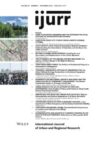This article advances a critique of the ‘neighbourhood effects’ genre in urban studies, by arguing that an acceptance of the ‘where you live affects your life chances’ thesis, however well‐intentioned, misses the key structural question of why people live where they do in cities. By examining the structural factors that give rise to differential life chances and the inequalities they produce, and by inverting the neighbourhood effects thesis to: your life chances affect where you live, the problem becomes one of understanding life chances via a theory of capital accumulation and class struggle in cities. Such a theory provides an understanding of the injustices inherent in letting the market (buttressed by the state) be the force that determines the cost of housing and therefore being the major determinant of where people live. The article draws on Marxist urban theory to contend that the residential mobility programs advocated by neighbourhood effects proponents stand on shaky ground, for if it is true that ‘neighbourhood effects’ exceed what would be predicted by poverty alone, moving the poor to a richer place would only eliminate that incremental difference, without addressing the capitalist institutional arrangements that create poverty.
Details
Written by:
Tom Slater
Digital Object Identifier (DOI)
10.1111/j.1468-2427.2013.01215.x
About DOI
Read full article as PDF
Read full article as HTML
See the references for this article
